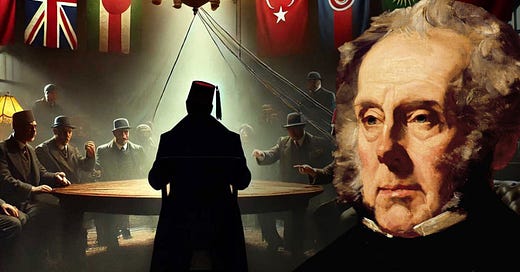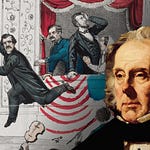Episode 01 - Solving the Paradox of Current World History
Episode 03 - The Venetian Takeover of England: A 200-Year Project
Episode 05 - Bestial British Intelligence Of Shelburne and Bentham
Episode 07 - Palmerston Launches Young Turks to Permanently Control the Middle East
Episode 09 - Jim Crow, a Cultural Weapon in the Hands of the Confederacy
Palmerston’s Plan: How British Influence Engineered the Young Turks to Control the Middle East
In the 19th century, British intelligence forged a master plan for the Middle East, wielding nationalist movements to dismantle the Ottoman Empire from within. This agenda, woven into Lord Palmerston’s imperial ambitions, sought to cultivate and control a cadre of revolutionary movements—chief among them, the Young Turks. These forces were manipulated to ultimately fracture Ottoman cohesion and lay the groundwork for enduring British control over the Middle East. Through secret societies, influential figures, and covert support for emerging national identities, British agents drove a strategy of internal division, rendering a multi-ethnic empire vulnerable and open to eventual partition.
📜 The Role of Secret Societies and British Agents
The B’nai B’rith, a seemingly independent organization, was in truth a calculated instrument of British intelligence. From its inception, B’nai B’rith served British objectives, functioning not for the interests of its Jewish members but as a malleable tool of imperial strategy. Unlike other entities, B’nai B’rith had a unique permanence, adaptable to new epochs and changing British needs, continuously evolving to advance British influence globally. By infiltrating diverse political landscapes, this secret society remained indispensable in executing plans that other, more transient groups could not achieve.
Across Europe and the Ottoman Empire, figures like Giuseppe Mazzini initiated nationalist uprisings aligned with British priorities. Mazzini’s influence, manifesting in secret societies and revolutionary cells, provided a crucial model for later British interventions. Masonic lodges, particularly in Italy and the Ottoman territories, became organizing centers for British-aligned forces. Italian B’nai B’rith officials like Emmanuel Carasso led this charge, establishing covert networks within Masonic lodges in Salonika and setting the foundation for what would become the Young Turks.
🌍 Rise of the Young Turks and British Support
As the 20th century dawned, the Ottoman Empire was marked as “the sick man of Europe,” ripe for exploitation by British designs. The empire, already weakened by political and economic strife, encompassed a diverse array of ethnic groups: Turks, Slavs, Greeks, Arabs, Armenians, and Kurds. The Young Turks, formed under Carasso’s leadership, first took power in 1908 under the guise of democratic reform, only to pivot sharply to a platform of ethnic supremacy and repression. Their governance stoked tensions, ultimately provoking the Balkan Wars of 1912-1913.
While the Young Turks advanced a pan-Turkic ideal of uniting all Turkic peoples, this ambition meant an inevitable clash with Russia, where many Turkic populations lived. Yet the vision of pan-Turkism did not originate within Ottoman circles; rather, it was fostered by British agents as early as the 1860s. Figures like Arminius Vambery, a British operative, had long guided the sultan’s policies and secretly encouraged a vision of pan-Turkism to incite internal division and external conflicts. This strategy echoed in the parallel pan-Islamic movement, which British operatives, including the influential Wilfred Blunt, cultivated to serve as a foil against Russian influence. Such movements ensured the Ottoman Empire’s unity was strained on multiple fronts, each designed to play into British plans for gradual dismemberment.
⚔️ Balkan Wars and Ottoman Fragmentation
The Young Turks’ rule, marked by suppression of minority populations, led directly to the Balkan Wars and further loss of Ottoman territory. While nationalist independence movements grew within the empire, they were covertly encouraged and supported by Britain. By promoting Serbian, Albanian, and Bulgarian nationalism, Britain ensured continuous strife along the empire’s borders. In each case, independence movements were reinforced by British agents who saw in them an opportunity to weaken Ottoman defenses. Prominent figures such as Lady Dunham and Seton-Watson actively fostered these movements, securing local leaders who pledged allegiance to Britain while openly defying Ottoman rule.
British manipulation extended even to Armenia and Kurdistan, where promises of “Greater Armenia” and “Greater Kurdistan” fomented conflict and divided local support. The British pledged to support Armenian territorial ambitions at the expense of the Ottomans, only to later withdraw that backing and redirect it to the Kurds, creating a cycle of ethnic violence. In 1915, this explosive situation reached its tragic peak with the Armenian genocide, a grim fulfillment of British strategy to destabilize the empire through ethnic strife. The violence, perpetrated under the Young Turks, allowed Britain to exploit the Ottoman Empire’s “moral failings” as pretext for military and political intervention.
🔍 The Mechanics of British Influence within the Young Turks
Carasso’s secret society became a nucleus of Young Turk authority. Not only did Carasso guide the political steps of the movement, but he also maintained direct communication with British intelligence. Embedded within his Italian Masonic lodge in Salonika, Carasso oversaw key operations, including the strategic elimination of the sultan and control over wartime supplies. This Masonic link extended deep into the Young Turk leadership, with figures like Talaat Pasha embracing both Masonic and nationalist ideologies, a duality that bound them to British interests.
While the Young Turks publicly championed Ottoman unity, their internal actions—guided by British and Masonic agendas—ensured an opposite outcome. They suppressed rival ethnicities and dismantled any semblance of Ottoman cooperation. The movement’s leaders were strategically selected for their willingness to implement these divisive policies, ensuring the empire’s continued disintegration.
💥 World War I and the End of Ottoman Sovereignty
As British-supported tensions escalated within the empire, World War I erupted, marking the final phase of Ottoman decline. Through the Young Turks, Britain ensured that the Ottoman Empire’s collapse was both gradual and irreversible, designed to leave the region in a state of fragmentation ripe for British control. With the signing of the Sykes-Picot Agreement, the British and French formally divided the spoils, ensuring British dominance in Iraq, Jordan, and Palestine, while the French took Syria and Lebanon. By the war’s end, Britain’s use of nationalist groups like the Young Turks had not only destroyed the Ottoman Empire but reconfigured the Middle Eastern landscape in Britain’s favor.
The legacy of the Young Turks as British instruments of imperial strategy underscores the extent of covert influence exerted in the Middle East—a system of manipulation that sacrificed Ottoman sovereignty to British geopolitical ambitions. In crafting this web of control, Britain laid the groundwork for a Middle East shaped by division and external dominance, the repercussions of which echo through modern regional tensions and alignments.
Key Insights
B’nai B’rith’s Covert Operations: Operating as a front for British intelligence, B’nai B’rith facilitated nationalist agendas designed to divide the Ottoman Empire and expand British influence globally.
Young Turks’ British Origins: The Young Turks, purported revolutionaries, operated under covert British guidance, with leaders like Carasso drawing on Masonic networks to implement British-led reform.
Pan-Turkism and Pan-Islamism: These ideologies, introduced by British operatives, served to antagonize Russia and strain Ottoman cohesion, precipitating long-term instability in the empire.
Ethnic Suppression Policies: The Young Turks’ nationalist and pan-Turkic policies catalyzed Balkan Wars and weakened Ottoman territorial control, playing directly into British plans.
Balkan Nationalist Support: Britain’s backing of Serbian, Bulgarian, and Albanian independence movements intensified regional conflicts, driving the Ottoman Empire into a state of disarray.
Greater Armenia and Kurdistan: British intelligence exploited ethnic rivalries, using false promises of support to provoke conflict between Armenians and Kurds, culminating in tragic violence.
Role of Masonic Lodges: Secret societies, particularly Masonic lodges, became a central apparatus for British manipulation within the Young Turks, shaping Ottoman policy from within.
Manipulated Genocide: The British exploited ethnic violence as a destabilizing force, leveraging the Armenian genocide to further delegitimize Ottoman authority and justify intervention.
Sykes-Picot and Partition: Following World War I, the Sykes-Picot Agreement formalized the British-French division of Ottoman territories, securing British control in the Middle East.
Legacy of Division: British-engineered division through groups like the Young Turks permanently altered the Middle East, fostering a landscape of ongoing conflict and foreign dependency.
Timeline of Events
1800s
Rise of Secret Societies and British Strategy: British imperial strategy, led by figures like Lord Palmerston, leverages secret societies to control and destabilize target empires, including the Ottoman Empire.
1830s-1840s
Mazzini’s Nationalist Networks: Giuseppe Mazzini, an Italian nationalist, begins organizing secret societies across Europe with British support, influencing later nationalist movements within the Ottoman Empire.
1860s
Pan-Turkism Origins: British agent Arminius Vambery, a Hungarian Zionist and adviser to the Ottoman sultan, promotes pan-Turkism, setting the groundwork for future Turkish nationalist agendas that will align with British interests.
1870s
Pan-Islamism Promoted: British nobleman Wilfred Blunt, a high-ranking intelligence official, advocates pan-Islamism as a counter to Russian influence, aiming to draw Ottoman loyalties into conflict with Russia.
1890s
Formation of the Young Turks: Emmanuel Carasso, a B’nai B’rith official and Italian Freemason, establishes the Young Turks as a revolutionary secret society in Salonika, under the influence of British intelligence.
1908
Young Turks Coup: The Young Turks seize control of the Ottoman Empire in a military coup, deposing the sultan and taking on key administrative roles, initially under the guise of democratic reform.
1908-1912
Young Turks’ Suppression of Minorities: The Young Turks begin aggressive nationalist policies, suppressing non-Turkish ethnic groups and igniting tensions in multi-ethnic regions within the empire.
1912-1913
Balkan Wars: Ethnic suppression by the Young Turks leads to the Balkan Wars, where Ottoman territory is contested by Greece, Bulgaria, and Serbia, significantly weakening Ottoman control.
1914
World War I Outbreak: Rising tensions in the Balkans contribute to the outbreak of World War I, during which the Ottoman Empire allies with Germany. The war marks the beginning of the empire’s final collapse.
1915
Armenian Genocide: Under Young Turk leadership, Kurdish groups—believing they have British support—engage in genocidal violence against Armenians, a tragedy later leveraged by Britain as a moral basis for intervention.
1916
Sykes-Picot Agreement: Britain and France secretly negotiate the Sykes-Picot Agreement, planning to partition Ottoman lands after the war, assigning control over Iraq, Jordan, and Palestine to Britain, with Syria and Lebanon designated for France.
1917
End of Young Turk Rule and Ottoman Collapse: Following World War I, the Ottoman Empire is dismantled, with its former territories divided among European powers, notably Britain and France, solidifying British influence in the Middle East.
Palmerston’s Zoo Series
For the past 30 years, media and academia have largely ignored the groundbreaking lectures presented at the President's Day 1994 Schiller Institute and International Caucus of Labor Committees conference. Yet, they contain some of the most vital historical insights for anyone seeking to understand the forces shaping today's world. "Palmerston's Zoo" is a deep exploration into the intricate workings of British imperialism—revealing the key figures, strategies, and philosophies behind its shadowy influence over global politics. This series brings together eight distinct but interwoven narratives that expose the power structures, manipulations, and covert operations that have determined the course of world history.
The Duke Report presents this podcast as an opportunity to breathe new life into these timeless analyses, giving listeners a comprehensive perspective connecting past imperial strategies and present-day geopolitics. The impact of these lectures is staggering, providing crucial context for understanding current events—a context that has never been widely disseminated through mainstream academic or media channels. The insights offered here are not just historical; they are the key to unlocking the deeper narrative of how global influence operates, making this possibly the most important history lesson for 21st-century humans. Join us on a journey that defies conventional narratives, challenges accepted truths and provides an essential map to navigate the complexities of modern power.
Links to authors and sources:
Let me know if anyone has been left out













Share this post